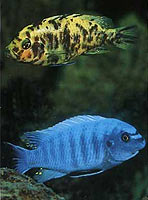 The sequencing of several Lake Malawi cichlid fish will contribute to major advances in our understanding of evolution in Lake Malawi cichlids. The lake is an evolutionary treasure trove in East Africa, home to more species of freshwater fish than all of Europe and North America combined. In part because cichlids are commonly used in aquariums or for food (e.g., tilapia), there is a large and diverse research community working on the development, neurobiology, ecology, evolution, physiology and aquaculture of cichlid fishes around the world. Researchers hope to identify single-nucleotide polymorphisms (SNPs) to better understand species divergences such as jaw morphology, the relationships between color patterns and visual systems, and sex determination. Sequencing will also facilitate studies of linkage disequilibrium, useful in discovering the evolutionary history of chromosomal regions involved in adaptive evolution and speciation.
The sequencing of several Lake Malawi cichlid fish will contribute to major advances in our understanding of evolution in Lake Malawi cichlids. The lake is an evolutionary treasure trove in East Africa, home to more species of freshwater fish than all of Europe and North America combined. In part because cichlids are commonly used in aquariums or for food (e.g., tilapia), there is a large and diverse research community working on the development, neurobiology, ecology, evolution, physiology and aquaculture of cichlid fishes around the world. Researchers hope to identify single-nucleotide polymorphisms (SNPs) to better understand species divergences such as jaw morphology, the relationships between color patterns and visual systems, and sex determination. Sequencing will also facilitate studies of linkage disequilibrium, useful in discovering the evolutionary history of chromosomal regions involved in adaptive evolution and speciation.
Because the Lake Malawi flock has evolved very recently, most species retain ancestral polymorphisms that arose before their species diverged. It has therefore been impossible to reconstruct the evolutionary history of species from the sequences of single genes. Some progress towards a phylogeny has been made by scoring thousands of restriction site polymorphisms in each species, but that method is cumbersome. A SNP-based approach to reconstructing the phylogenetic history of the flock would be a major boost to this research.
CSP project participants: Thomas D. Kocher (proposer) and Karen L. Carleton (Univ. of New Hampshire), R. Craig Albertson (Harvard Univ), Jody Hey (Rutgers Univ), Irv Kornfield (Univ. of Maine), J. Todd Streelman (Georgia Inst. of Technology), and George F. Turner (Univ. of Hull).